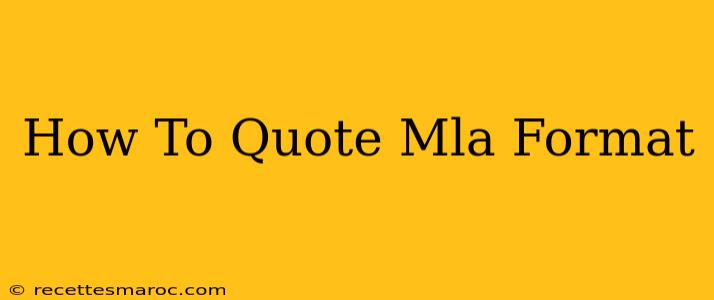Quoting sources correctly is crucial for academic integrity and avoiding plagiarism. The Modern Language Association (MLA) style is widely used in humanities disciplines, and understanding how to quote in MLA format is essential for students and researchers alike. This guide provides a comprehensive overview of MLA quotation rules, covering various scenarios and offering practical examples.
Understanding MLA Quotation Basics
The core principle of MLA quoting is to accurately represent the original source's meaning and provide clear attribution. This involves careful consideration of direct quotations (using the exact words of the author), indirect quotations (paraphrasing or summarizing), and block quotations (longer passages).
Direct Quotations: The Essentials
Direct quotations are verbatim reproductions of text. They are enclosed in double quotation marks (" "). Always integrate quotations smoothly into your sentence structure, avoiding abrupt shifts or awkward phrasing.
Example: Smith argues that "the impact of social media on politics is undeniable" (123).
Key Elements:
- Quotation Marks: Enclose the quoted material in double quotation marks.
- Parenthetical Citation: Immediately follow the quotation with a parenthetical citation including the author's last name and page number (or other relevant location information, such as paragraph number for online sources).
- Punctuation: Place periods and commas inside the closing quotation mark. Colons and semicolons go outside the closing quotation mark.
Integrating Quotations into Your Sentences
Avoid simply dropping quotations into your writing. Instead, use signal phrases to introduce the quote and contextually embed it within your sentence.
Examples:
- Signal Phrase: According to Smith, "the impact of social media on politics is undeniable" (123).
- Embedded Quote: Smith notes the "undeniable impact of social media on politics" (123).
Handling Ellipses and Brackets
-
Ellipses (...): Use ellipses to indicate omitted words within a quotation. However, do not use ellipses at the beginning or end of a quotation unless it is necessary to clarify the meaning.
-
Brackets [ ]: Use brackets to add your own words for clarification or to make a quotation grammatically consistent with your sentence.
Example: Smith states that "the study...revealed [a significant] correlation" (145).
Block Quotations: Handling Longer Passages
Block quotations are used for passages of four or more lines. They are indented one inch from the left margin, without quotation marks. The parenthetical citation follows the final punctuation mark.
Example:
The impact of social media is multifaceted. It has revolutionized communication, offering unprecedented opportunities for connection and information sharing. Yet, this also presents challenges, such as the spread of misinformation and the erosion of privacy. The implications for society are profound and continue to evolve. (Smith 124-125)
Quoting Poetry
When quoting poetry, follow these guidelines:
- Short Quotations: Use slashes (/) to indicate line breaks within a short quotation.
- Long Quotations: Use block quotation format for longer passages. Maintain original line breaks as much as possible.
Example (Short): Wordsworth describes nature as "a sea of daffodils,/a host, of golden daffodils" (12-13).
Quoting from Websites and Other Online Sources
Quoting online sources follows similar principles as printed sources but requires specific attention to URL and date of access. Always check your MLA handbook for the most up-to-date style guide.
Example: (Smith, "Social Media and Politics," para. 3)
Mastering MLA Quotation: Key Takeaways
Proficient MLA quotation ensures accurate representation of sources and strengthens your academic writing. Mastering the techniques of direct and indirect quotation, understanding the use of block quotations, and correctly handling ellipses and brackets are vital for producing clear, credible, and well-cited academic work. Always refer to the latest edition of the MLA Handbook for the most accurate and comprehensive guidance.

